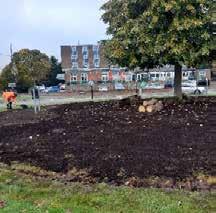ABBEY END ISLAND BIODIVERSITY UPDATE
Residents will have noticed a transformation in the centre of the traffic island at Abbey End in Kenilworth. This is just one traffic island of many in Warwick District to have biodiversity planting, and Abbey End is the largest and last traffic island to be re landscaped with works being conducted over a 20-year period.
WDC Officer, Jon Holmes designed the islands and has planned, sourced and implemented the design over the past month for Abbey End. He was helped in the planting by a 2-man team from Idverde. A great deal of thought has gone into the design of the space, so it provides seasonal colour and interest and is climate resilient once established, which makes it a haven for insects and plants, and a space to be enjoyed by residents.
Approximately 500 of the plants have been sourced from established sustainable planting schemes in the district, with another 1,200 other plants brought in.



Hydration
The team have created pools for the insects to drink from. These have been created by re-purposing discarded dust bin lids. As with every living creature, water is a vital part of an insect’s requirements for survival. Insects will either lap up the water like a cat or dog (Ants/Wasps) or sip it like a human using a straw. (Honeybees)
Warmth
This structure has been installed for invertebrates to hide under and provides damp cooler places which are good for beetles. Insects use the exposed stone and gravel to warm up on, as most insects need warmth to heat their blood. The stone retains the heat so helps to warm up insects in the morning, or they can just use it for basking on a sunny day.
Accommodation
Dead trees are anything but dead, they provide the habitat for a lot of different varieties of insects. These include woodlice, millipedes, beetles, spiders, slugs, snails, worms and many more. The team have installed log sections to benefit these types of insects.
Holes drilled in the log piles will help encourage solitary bees to colonise within the piles. A bug hotel will also be installed on the central tree trunk to further help solitary bees.
The team have also added rolls of turf. These will become home to many of the insects mentioned above.



Planting
The central feature tree is a silver weeping lime planted years ago, selected as part of a previous design, it has established well and is a beautiful centrepiece. This tree has a wonderful scent, which on a good day drifts over Abbey End, its flowers provide nectar and pollen, its leaves will contribute to organic matter, which is good for worms, in turn providing drainage and nutrients.

All the planting has been carefully considered and is sustainable/ perennial. Warwick District Council will not need to plant and then remove bedding plants as they have done in previous years. This reduces watering and maintenance, and the carbon foot print, while increasing biodiversity.
Just a few of the 30 plus varieties of plants on the island include:
Veronicastium Virginianium ‘ Fascination, Kiniphofia Tawny King, Persicaria Amplexicaulis Orange Field, Solidago ‘Goldkind’, Phlomis Russeliana, Teucrium x Lucidrys, Stachys Byzantina, Sedum Autumn Joy, Origanium Vulgare, Geranium Phaeum ‘Walkure’, Geranium ‘Rozanne’
The plants have been chosen to provide seasonal colour throughout the year, flowers that provide nectar and pollen, different heights, and forms to add appeal to the eye of the onlooker. The scheme has a tiered structure with shorter plants around the perimeter, taller plants to the middle, shade tolerant plants under the tree, with a small low evergreen hedge in a circle which will be good for hibernating insects once established. Some of the plants are tall and will be managed by the Chelsea chop method, cut them in half in May to keep them smaller and bushier to withstand the rigours of this location.
Bulbs have been planted around the perimeter of the island with Grape Hyacinth and snow drops being planted in patches this spring, and daffodils in the coming autumn.
This will add to the bulbs already planted in the splitter islands that have been turfed over , 10,000 crocus and dwarf daffodils were planted in these areas in November 2023
The bulbs have been chosen to give nectar and pollen for insects and give a spring lift to everyone’s spirits after the dark days of winter.
Ongoing maintenance and plans
The island will receive regular maintenance visits to keep weeds under control and the plants maintained, and watering will be done if required for the first season. In the autumn plants with winter appeal will be left to provide colour and interest and will be cut down in the spring.
The centre island grass will be cut regularly, and the splitter island grass will be cut after the bulbs have finished flowering and the leaves of the bulbs have died. This will allow the bulbs to replenish themselves to ensure they flower for many years to come. The grass will be cut regularly from then on. Other activities include:

• Monitoring of plants, and tweaks made as required.
• Water features will be cleaned once a month.
• Log piles will be monitored to keep safe and secure.
• Turf mounds will be clipped to keep grass reasonable short and to stop it seeding.
• Remaining bulb planting will be completed in autumn 2024.
For more information please email: greenspaces@warwickdc.gov.uk warwickdc.gov.uk








